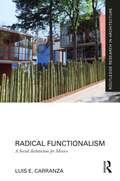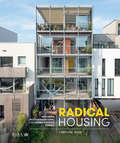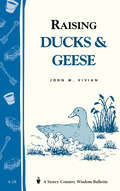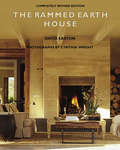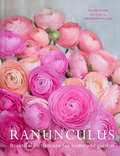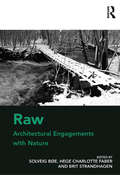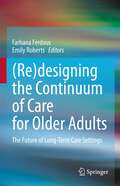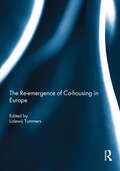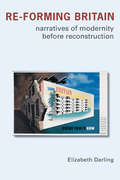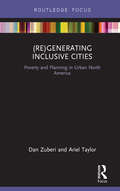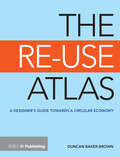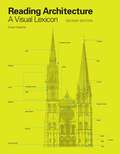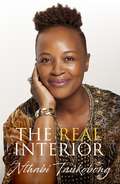- Table View
- List View
Radical Functionalism: A Social Architecture for Mexico (Routledge Research in Architecture)
by Luis E. CarranzaRadical Functionalism: A Social Architecture for Mexico provides a complex and nuanced understanding of the functionalist architecture developed in Mexico during the 1930s. It carefully re-reads the central texts and projects of its main advocates to show how their theories responded to the socially and culturally charged Mexican context. These, such as architects Juan Legarreta, Juan O’Gorman, the Union of Socialist Architects, and Manuel Amábilis, were part of broader explorations to develop a modern, national architecture intended to address the needs of the Mexican working classes. Through their refunctioning of functionalism, these radical thinkers showed how architecture could stand at the precipice of Mexico's impending modernization and respond to its impending changes. The book examines their engagement and negotiation with foreign influences, issues of gender and class, and the separation between art and architecture. Functionalist practices are presented as contradictory and experimental, as challenging the role of architecture in the transformation of society, and as intimately linked to art and local culture in the development of new forms of architecture for Mexico, including the "vernacularization" of functionalism itself. Uniquely including translations of two manifesto-like texts by O’Gorman expressing the polemical nature of their investigations, Radical Functionalism: A Social Architecture for Mexico will be a useful reference for scholars, researchers and students interested in the history of architectural movements.
Radical Functionalism: A Social Architecture for Mexico (Routledge Research in Architecture)
by Luis E. CarranzaRadical Functionalism: A Social Architecture for Mexico provides a complex and nuanced understanding of the functionalist architecture developed in Mexico during the 1930s. It carefully re-reads the central texts and projects of its main advocates to show how their theories responded to the socially and culturally charged Mexican context. These, such as architects Juan Legarreta, Juan O’Gorman, the Union of Socialist Architects, and Manuel Amábilis, were part of broader explorations to develop a modern, national architecture intended to address the needs of the Mexican working classes. Through their refunctioning of functionalism, these radical thinkers showed how architecture could stand at the precipice of Mexico's impending modernization and respond to its impending changes. The book examines their engagement and negotiation with foreign influences, issues of gender and class, and the separation between art and architecture. Functionalist practices are presented as contradictory and experimental, as challenging the role of architecture in the transformation of society, and as intimately linked to art and local culture in the development of new forms of architecture for Mexico, including the "vernacularization" of functionalism itself. Uniquely including translations of two manifesto-like texts by O’Gorman expressing the polemical nature of their investigations, Radical Functionalism: A Social Architecture for Mexico will be a useful reference for scholars, researchers and students interested in the history of architectural movements.
Radical Housing: Designing multi-generational and co-living housing for all
by Caroline DoveRadical Housing explores the planning, technical, financial, health-based and social background for developing multi-generational homes and co-living. Abundantly illustrated with case studies and plans from projects across the UK and abroad, this book inform sand inspires the delivery of alternative approaches to affordable and flexible housing, and is an essential text for architecture practitioners, students, and community groups.
Radical Housing: Designing multi-generational and co-living housing for all
by Caroline DoveRadical Housing explores the planning, technical, financial, health-based and social background for developing multi-generational homes and co-living. Abundantly illustrated with case studies and plans from projects across the UK and abroad, this book inform sand inspires the delivery of alternative approaches to affordable and flexible housing, and is an essential text for architecture practitioners, students, and community groups.
Rag Doll (large print)
by Rnib BookshareThis is a picture of an old-fashioned rag doll. There is a locator dot shown, which will be at the top left of the page when the image is the right way up. She is standing in the middle of the page and facing you, with her head at the top. On top of the doll's head is her woolly hair. It sticks out on each side of her head in bunches, which are tied with bands. She has button eyes, a small nose and a big smiley mouth. The doll is wearing a long-sleeved dress with a frilly collar. Her hands have thumbs not proper fingers. Her legs and feet are at the bottom of the page.
Rag Doll (UEB Contracted)
by Rnib BookshareThis is a picture of an old-fashioned rag doll. There is a locator dot shown, which will be at the top left of the page when the image is the right way up. She is standing in the middle of the page and facing you, with her head at the top. On top of the doll's head is her woolly hair. It sticks out on each side of her head in bunches, which are tied with bands. She has button eyes, a small nose and a big smiley mouth. The doll is wearing a long-sleeved dress with a frilly collar. Her hands have thumbs not proper fingers. Her legs and feet are at the bottom of the page.
Rag Doll (UEB Uncontracted)
by Rnib BookshareThis is a picture of an old-fashioned rag doll. There is a locator dot shown, which will be at the top left of the page when the image is the right way up. She is standing in the middle of the page and facing you, with her head at the top. On top of the doll's head is her woolly hair. It sticks out on each side of her head in bunches, which are tied with bands. She has button eyes, a small nose and a big smiley mouth. The doll is wearing a long-sleeved dress with a frilly collar. Her hands have thumbs not proper fingers. Her legs and feet are at the bottom of the page.
Raising Ducks & Geese: Storey's Country Wisdom Bulletin A-18 (Storey Country Wisdom Bulletin)
by John VivianSince 1973, Storey's Country Wisdom Bulletins have offered practical, hands-on instructions designed to help readers master dozens of country living skills quickly and easily. There are now more than 170 titles in this series, and their remarkable popularity reflects the common desire of country and city dwellers alike to cultivate personal independence in everyday life.
The Rammed Earth House: Revised Edition (Real Goods Independent Living Bks.)
by David Easton Cynthia WrightThe Rammed Earth House is an eye-opening example of how the most dramatic innovations in home design and construction frequently have their origins in the distant past. By rediscovering the most ancient of all building materials —earth—forward-thinking homebuilders can now create structures that set new standards for beauty, durability, and efficient use of natural resources. Rammed earth construction is a step forward into a sustainable future, when homes will combine pleasing aesthetics and intense practicality with a powerful sense of place. Rammed earth homes are built entirely on-site, using basic elements—earth, water, and a little cement. The solid masonry walls permit design flexibility while providing year-round comfort and minimal use of energy. The builder and resident of a rammed earth house will experience the deep satisfaction of creating permanence in a world dominated by the disposable.
Ranunculus: Beautiful Buttercups For Home And Garden
by Naomi SladeRanunculus offers advice on how to care for and propagate these colourful cultivated members of the buttercup family. Naomi Slade explores a wide range of ranunculus species and cultivars, all beautifully photographed by Georgianna Lane in their technicolour glory from palest pink to deep burgundy via white, orange, red and yellow.
Raw: Architectural Engagements With Nature
by Solveig Bøe Hege Charlotte FaberThrough cross-disciplinary explorations of and engagements with nature as a forming part of architecture, this volume sheds light on the concepts of both nature and architecture. Nature is examined in a raw intermediary state, where it is noticeable as nature, despite, but at the same time through, man’s effort at creating form. This is done by approaching nature from the perspective of architecture, understood, not only as concrete buildings, but as a fundamental human way both of being in, and relating to, the world. Man finds and forms places where life may take place. Consequently, architecture may be understood as ranging from the simple mark on the ground and primitive enclosure, to the contemporary megalopolis. Nature inheres in many aesthetic forms of expression. In architecture, however, nature emerges with a particular power and clarity, which makes architecture a raw kind of art. Even though other forms of art, as well as aesthetic phenomena outside the arts, are addressed, the analogy to architecture will be evident and important. Thus, by using the concept of ’raw’ as a focal point, this book provides new approaches to architecture in a broad sense, as well as other aesthetic and artistic practices, and will be of interest to readers from different fields of the arts and humanities, spanning from philosophy and theology to history of art, architecture and music.
Raw: Architectural Engagements with Nature
by Solveig Bøe Hege Charlotte FaberThrough cross-disciplinary explorations of and engagements with nature as a forming part of architecture, this volume sheds light on the concepts of both nature and architecture. Nature is examined in a raw intermediary state, where it is noticeable as nature, despite, but at the same time through, man’s effort at creating form. This is done by approaching nature from the perspective of architecture, understood, not only as concrete buildings, but as a fundamental human way both of being in, and relating to, the world. Man finds and forms places where life may take place. Consequently, architecture may be understood as ranging from the simple mark on the ground and primitive enclosure, to the contemporary megalopolis. Nature inheres in many aesthetic forms of expression. In architecture, however, nature emerges with a particular power and clarity, which makes architecture a raw kind of art. Even though other forms of art, as well as aesthetic phenomena outside the arts, are addressed, the analogy to architecture will be evident and important. Thus, by using the concept of ’raw’ as a focal point, this book provides new approaches to architecture in a broad sense, as well as other aesthetic and artistic practices, and will be of interest to readers from different fields of the arts and humanities, spanning from philosophy and theology to history of art, architecture and music.
(Re)designing the Continuum of Care for Older Adults: The Future of Long-Term Care Settings
by Farhana Ferdous Emily RobertsThis book broadens the visioning on new care environments that are designed to be inclusive, progressive, and convergent with the needs of an aging population. The contents cover a range of long-term care (LTC) settings in a single collection to address the needs of a wide audience.Due to the recent COVID-19 pandemic, rethinking the spatial design of care facilities in order to prepare for future respiratory and contagious pathogens is one of the prime concerns across the globe, along with social connectedness and autonomy in care settings. This book contributes to the next generation of knowledge and understanding of the growing field of the design of technology, programs, and environments for LTC that are more effective in infection prevention and control as well as social connectedness. To address these issues, the chapters are organized in four sections: Part I: Home- and community-based care; Part II: Facility-based care; Part III: Memory care and end-of-life care; and Part IV: Evidence-based applied projects and next steps. (Re)designing the Continuum of Care for Older Adults: The Future of Long-Term Care Settings is an essential resource for researchers, practitioners, educators, policymakers, and students associated with LTC home and healthcare settings. With diverse topics in theory, substantive issues, and methods, the contributions from notable researchers and scholars cover a range of innovative programming, environments, and technologies which can impact the changing needs and support for older adults and their families across the continuum of care.
The re-emergence of co-housing in Europe
by Lidewij TummersAcross Europe, the number of co-housing initiatives is growing, and they are increasingly receiving attention from administrators and professionals who hold high expectations for urban liveability. Is co-housing a marginal idealist phenomenon, or the urban middle class’ answer to the current housing crisis? And has the development of theoretical insight and research kept up with the actual expansion of co-housing as a practice? These questions were raised during the first European conference on co-housing research, which took place in Tours, France, in March 2012. Both the conference and this book aim to move beyond case-studies, and to look more particularly at the implications and wider perspective of the current co-housing trend.Using the specific vocabulary of different disciplines and geographic regions, the contributions to this book analyse the underlying thinking behind, and the expectations projected on, diverse models of collaborative housing. The authors are aware of the qualities of contemporary co-housing, but they go beyond advocacy to investigate the conditions under which co-housing can be successful as a strategy for housing provision; can offer solutions for sustainable urban development; or indeed can contribute to involuntary or intentional gentrification. This book was originally published as a special issue of the Journal of Urban Research and Practice.
The re-emergence of co-housing in Europe
by Lidewij TummersAcross Europe, the number of co-housing initiatives is growing, and they are increasingly receiving attention from administrators and professionals who hold high expectations for urban liveability. Is co-housing a marginal idealist phenomenon, or the urban middle class’ answer to the current housing crisis? And has the development of theoretical insight and research kept up with the actual expansion of co-housing as a practice? These questions were raised during the first European conference on co-housing research, which took place in Tours, France, in March 2012. Both the conference and this book aim to move beyond case-studies, and to look more particularly at the implications and wider perspective of the current co-housing trend.Using the specific vocabulary of different disciplines and geographic regions, the contributions to this book analyse the underlying thinking behind, and the expectations projected on, diverse models of collaborative housing. The authors are aware of the qualities of contemporary co-housing, but they go beyond advocacy to investigate the conditions under which co-housing can be successful as a strategy for housing provision; can offer solutions for sustainable urban development; or indeed can contribute to involuntary or intentional gentrification. This book was originally published as a special issue of the Journal of Urban Research and Practice.
Re-forming Britain: Narratives of Modernity before Reconstruction
by Elizabeth DarlingRe-forming Britain considers the nature and practice of architectural modernism in inter-war Britain in a new light. Bringing hitherto little considered protagonists and projects to the fore, it argues that rather than being an imported idiom, the new architecture in Britain formed part of an ongoing attempt to make a modern nation. Spanning the period 1925-42, the book focuses on the key sites from and through which architectural modernism emerged in the UK. Part one considers the main arena in which a will to modernize Britain developed in the 1920s. In parts two and three the author documents, contextualizes and explains how this modernizing will was given modernist form, discussing the work of architects such as Wells Coates, Maxwell Fry, and Connell and Ward, and their allied ventures with likeminded reformers in other fields. These collaborations produced ‘narratives of modernity’: buildings, projects, exhibitions and books, through which, the book argues, modernist reformers were able to persuade politicians, and those with influence upon them, that modernism was the means to re-form the nation. Re-forming Britain offers the first in-depth analysis of well-known modernist schemes such as Kensal House and the Pioneer Health Centre but also brings previously little studied or unknown activities to light. This important work invites a new understanding of the nature of architectural modernism in inter-war Britain and the ways in which it ultimately gave form to post-war Britain.
Re-forming Britain: Narratives of Modernity before Reconstruction
by Elizabeth DarlingRe-forming Britain considers the nature and practice of architectural modernism in inter-war Britain in a new light. Bringing hitherto little considered protagonists and projects to the fore, it argues that rather than being an imported idiom, the new architecture in Britain formed part of an ongoing attempt to make a modern nation. Spanning the period 1925-42, the book focuses on the key sites from and through which architectural modernism emerged in the UK. Part one considers the main arena in which a will to modernize Britain developed in the 1920s. In parts two and three the author documents, contextualizes and explains how this modernizing will was given modernist form, discussing the work of architects such as Wells Coates, Maxwell Fry, and Connell and Ward, and their allied ventures with likeminded reformers in other fields. These collaborations produced ‘narratives of modernity’: buildings, projects, exhibitions and books, through which, the book argues, modernist reformers were able to persuade politicians, and those with influence upon them, that modernism was the means to re-form the nation. Re-forming Britain offers the first in-depth analysis of well-known modernist schemes such as Kensal House and the Pioneer Health Centre but also brings previously little studied or unknown activities to light. This important work invites a new understanding of the nature of architectural modernism in inter-war Britain and the ways in which it ultimately gave form to post-war Britain.
(Re)Generating Inclusive Cities: Poverty and Planning in Urban North America
by Dan Zuberi Ariel Judith TaylorAs suburban expansion declines, cities have become essential economic, cultural and social hubs of global connectivity. This book is about urban revitalization across North America, in cities including San Francisco, Toronto, Boston, Vancouver, New York and Seattle. Infrastructure projects including the High Line and Big Dig are explored alongside urban neighborhood creation and regeneration projects such as Hunters Point in San Francisco and Regent Park in Toronto. Today, these urban regeneration projects have evolved in the context of unprecedented neoliberal public policy and soaring real estate prices. Consequently, they make a complex contribution to urban inequality and poverty trends in many of these cities, including the suburbanization of immigrant settlement and rising inequality. (Re)Generating Inclusive Cities wrestles with challenging but important questions of urban planning, including who benefits and who loses with these urban regeneration schemes, and what policy tools can be used to mitigate harm? We propose a new way forward for understanding and promoting better urban design practices in order to build more socially just and inclusive cities and to ultimately improve the quality of urban life for all.
(Re)Generating Inclusive Cities: Poverty and Planning in Urban North America
by Dan Zuberi Ariel Judith TaylorAs suburban expansion declines, cities have become essential economic, cultural and social hubs of global connectivity. This book is about urban revitalization across North America, in cities including San Francisco, Toronto, Boston, Vancouver, New York and Seattle. Infrastructure projects including the High Line and Big Dig are explored alongside urban neighborhood creation and regeneration projects such as Hunters Point in San Francisco and Regent Park in Toronto. Today, these urban regeneration projects have evolved in the context of unprecedented neoliberal public policy and soaring real estate prices. Consequently, they make a complex contribution to urban inequality and poverty trends in many of these cities, including the suburbanization of immigrant settlement and rising inequality. (Re)Generating Inclusive Cities wrestles with challenging but important questions of urban planning, including who benefits and who loses with these urban regeneration schemes, and what policy tools can be used to mitigate harm? We propose a new way forward for understanding and promoting better urban design practices in order to build more socially just and inclusive cities and to ultimately improve the quality of urban life for all.
The Re-Use Atlas: A Designer's Guide Towards the Circular Economy
by Duncan Baker-BrownThis book is a highly illustrated “map,” using photos, infographics and statistics, showing designers how they can successfully navigate the emerging field of resource management and the circular economy. Using the Brighton Waste House Project as a basis for this, the book will look at key moments and landmark decisions made during its design and construction, as well as the people and projects from around the world that inspired them.
The Re-Use Atlas: A Designer's Guide Towards the Circular Economy
by Duncan Baker-BrownThis book is a highly illustrated “map,” using photos, infographics and statistics, showing designers how they can successfully navigate the emerging field of resource management and the circular economy. Using the Brighton Waste House Project as a basis for this, the book will look at key moments and landmark decisions made during its design and construction, as well as the people and projects from around the world that inspired them.
The Re-use Atlas: A Designer's Guide Towards a Circular Economy
by Duncan Baker-BrownDo you know how to design for a circular economy? A truly sustainable, circular economy is both a robust and viable option for architecture. Through 24 inspirational case studies, interviews and essays, this book is an accessible and practical guide to how architects can move from a linear economy towards a circular economy. This atlas to sustainable, closed-loop systems takes the reader on a journey through four distinct steps (Recycle, Reuse, Reduce, Circular Economy) that show how they can dramatically reduce the negative impact humans have on the planet. It gives architects the skills and knowledge to navigate through the emerging fields of resource management towards a true Circular Economy. Each step is supplemented with an in-depth interview with an expert who is successfully tacking one or more of the challenges facing all designers today. If we change our behaviour, we enable humanity to work with nature rather than against it. Be part of the change.
The Re-use Atlas: A Designer's Guide Towards a Circular Economy
by Duncan Baker-BrownDo you know how to design for a circular economy? A truly sustainable, circular economy is both a robust and viable option for architecture. Through 24 inspirational case studies, interviews and essays, this book is an accessible and practical guide to how architects can move from a linear economy towards a circular economy. This atlas to sustainable, closed-loop systems takes the reader on a journey through four distinct steps (Recycle, Reuse, Reduce, Circular Economy) that show how they can dramatically reduce the negative impact humans have on the planet. It gives architects the skills and knowledge to navigate through the emerging fields of resource management towards a true Circular Economy. Each step is supplemented with an in-depth interview with an expert who is successfully tacking one or more of the challenges facing all designers today. If we change our behaviour, we enable humanity to work with nature rather than against it. Be part of the change.
Reading Architecture Second Edition: A Visual Lexicon
by Owen HopkinsAnyone with an interest in buildings and the built environment would do well to purchase a copy of Owen Hopkins' book. - MonocleThis innovative and unique book is a visual guide to the buildings that surround us. Architectural features are pinpointed and labelled on images of buildings so that, unlike with other architectural dictionaries, you don't have to know the name before looking it up. Clear line drawings and extensive colour photographs illustrate each of the main building types, from forts to churches, stately homes to skyscrapers. The individual structural elements and materials common to all buildings are then explained, whether in Classical, Gothic or Modernist style. A comprehensive glossary completes the book. This revised edition includes an expanded section on modern structures and materials, as well as the latest styles and concepts from the last ten years. A must for all lovers of architecture and those who would like to learn moreOver 11,000 copies sold in English worldwide Covers all key building types and styles, from cathedrals to skyscrapers, Classical to contemporary. Each building type is illustrated with extensive photographs and annotated drawings Contains a comprehensive glossary of architectural terms
The Real Interior
by Nthabi Taukobong“In my own home is where my journey of healing began.” – NTHABI TAUKOBONGThe Real Interior not only allows the reader a behind-the-scenes peek into the glitz and glamour of design and décor, but into a career once never considered an option for a young girl, born in Soweto.As one of the first black and very recognisable faces of Interior Design in Africa, Nthabi Taukobong was thrust into the limelight from the very start of her profession. Spanning a career of more than 23 years she has worked on esteemed residential and leisure projects for presidents, African royalty, captains of industry and five-star hotels, to name but a few.Through the rough and often very challenging terrain of her chosen career, sprinkled generously with the high-end glamour of prestigious interiors that Nthabi has been privileged to work on, she learned that she, in fact, had to be seated right within her own interior before she could offer anything further to those in search of her creative gift.And as she searched and explored the greater world of design, trying to grasp what it really took to be an esteemed designer, the journey unexpectedly brought her right back into her own home. Not only Nthabi’s physical home, but also to her inner-home, the place that she refers to as her real interior.It was in writing a letter one evening, congratulating herself on reaching the milestone of 21 years in her career, that Nthabi discovered she was not only writing to herself, but to every creative.Her letter ended up being an entire book and Nthabi finally understood how her unique story could inspire and encourage others.
